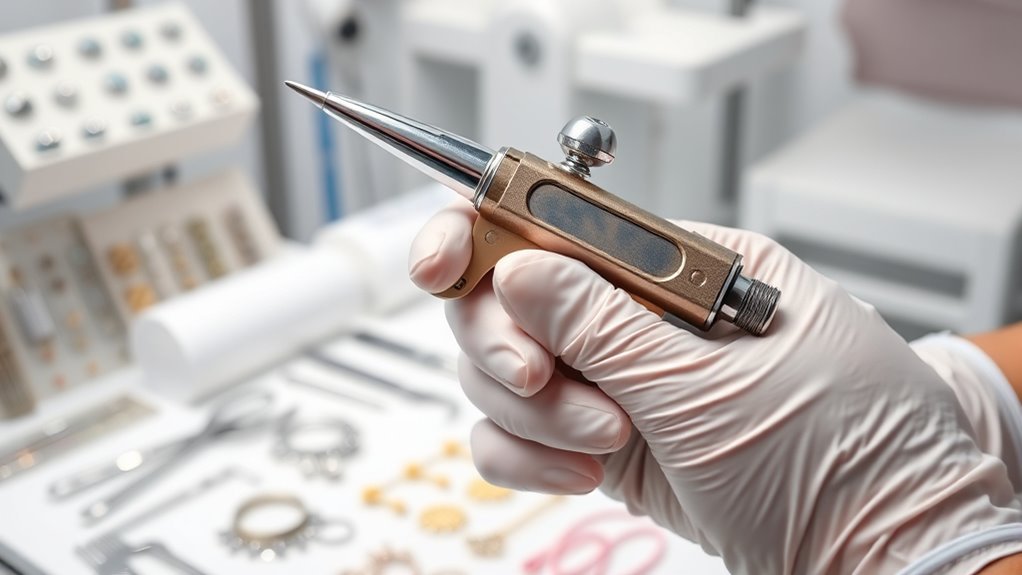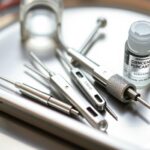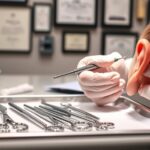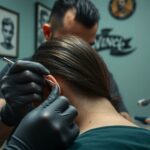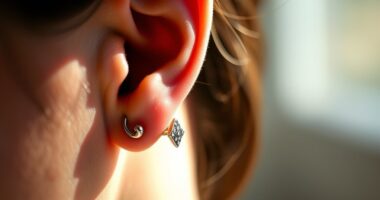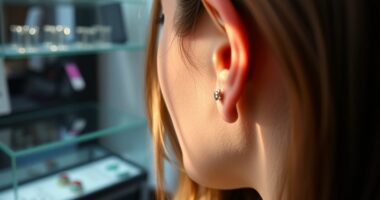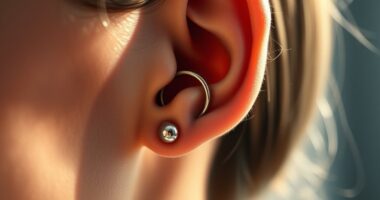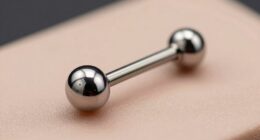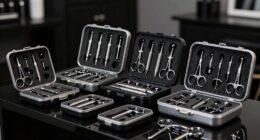Piercing guns are generally not considered safe due to design limitations that make effective sterilization difficult, increasing infection risks. Modern standards emphasize using disposable needles and thorough sterilization of all equipment, which guns often can’t meet. Professional studios that follow strict hygiene protocols and proper training offer safer options. If you want to understand why many experts advise against piercing guns and what safer alternatives exist, there’s more to uncover here.
Key Takeaways
- Proper sterilization of equipment and single-use needles are essential for safe piercing; guns often have design limitations that hinder sterilization.
- Trained professionals following strict hygiene and safety protocols significantly reduce infection and complication risks.
- Modern standards emphasize the use of disposable needles and sterilization procedures, making professional piercings safer than gun-based methods.
- Piercing guns are generally not designed for effective sterilization, increasing safety concerns, especially outside regulated environments.
- Choosing reputable studios with trained staff and proper hygiene practices ensures safer piercing experiences.
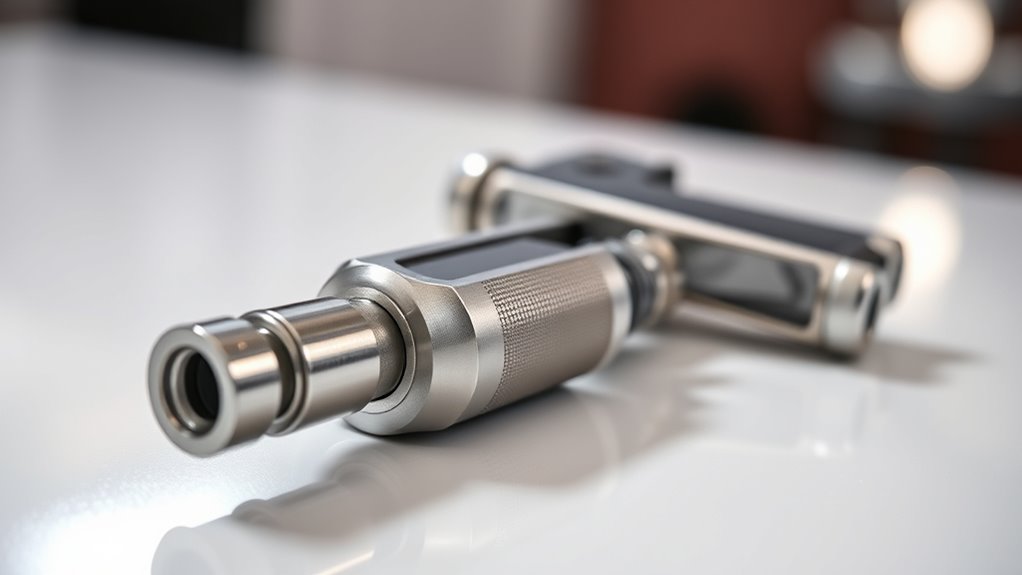
Piercing guns are popular for quick and easy piercings, but their safety depends on proper use and hygiene. When considering whether piercing guns are safe, it’s essential to understand how sterilization procedures and professional training influence safety standards. Many people assume that because piercing guns are convenient, they’re automatically safe. However, the reality is that if sterilization procedures aren’t strictly followed, the risk of infection increases considerably. Proper sterilization involves thoroughly disinfecting all parts of the gun and needles used during the piercing. Single-use, pre-sterilized needles should be used each time, and the gun itself should be sterilized after every use. Without rigorous sterilization procedures, bacteria and pathogens can transfer from one customer to another, leading to serious infections or complications. Additionally, the design limitations of piercing guns often make it difficult to sterilize all components effectively, increasing safety concerns. Professional training is another critical factor. Not everyone operating a piercing gun has the necessary expertise to perform the procedure safely. Proper training ensures that the piercer understands anatomy, placement, and hygiene protocols. A trained professional knows how to handle sterilized equipment correctly, reducing the chance of contamination. They also know how to manage emergencies or adverse reactions efficiently. Unfortunately, many untrained individuals or inexperienced staff may overlook essential steps or mishandle equipment, which compromises safety. Certification and extensive training are crucial in ensuring that the person performing the piercing adheres to modern safety standards. Modern standards emphasize strict adherence to hygiene practices and thorough training. Professional piercing studios invest in training staff thoroughly on sterilization procedures and proper techniques. They follow regulations designed to minimize risks, such as using disposable needles and sterilizing reusable tools with medical-grade sterilizers. These standards aim to protect clients from infections, allergic reactions, and other complications. It’s worth noting that piercing guns are often not designed for repeated sterilization, unlike professional piercing needles, making them a less safe option in regulated environments. Ultimately, the safety of piercing guns hinges on the environment in which they’re used. When operated by trained professionals who follow strict sterilization procedures, the risks are minimized, but they’re rarely eliminated entirely. Proper training ensures that safety protocols are consistently followed, making the experience safer for clients. Without these standards, the potential for infection, scarring, or other health issues increases. If you’re considering a piercing, it’s best to choose a reputable studio that prioritizes hygiene, employs trained staff, and follows modern safety standards to ensure your health and well-being.
Frequently Asked Questions
Are Piercing Guns Suitable for All Skin Types?
Piercing guns aren’t suitable for all skin types, especially if you have sensitive skin. They can cause more trauma and irritation, making healing difficult. For better piercing versatility, consider professional alternatives like piercing needles, which are gentler and more precise. If you have skin sensitivity, opting for a professional piercing guarantees safer results and reduces the risk of complications, providing a better experience tailored to your skin’s needs.
How Often Are Piercing Guns Properly Sterilized?
Imagine a well-oiled machine humming smoothly—that’s how sterilization protocols should work for piercing guns. You need to guarantee they’re properly cleaned and sterilized after each use, following strict hygiene standards. In reality, many guns aren’t sterilized often enough, risking infection. Proper sterilization isn’t a one-time thing; it’s a continuous process that keeps you safe, preventing bacteria from lurking where they shouldn’t be.
Do Piercing Guns Cause More Tissue Damage?
Piercing guns can cause more tissue trauma because they often lack piercing accuracy, leading to uneven or unnecessary damage. The force used may tear or crush tissue, increasing healing time and discomfort. Unlike professional needle piercings, guns don’t allow precise control, making tissue trauma more likely. For safer, cleaner results, consider professional piercing methods that prioritize piercing accuracy and minimize tissue damage.
Can Piercing Guns Be Used for Cartilage Piercings?
You might wonder if a piercing gun can be used for ear cartilage. While some salons claim they can, it’s generally not recommended. Piercing guns aren’t designed for cartilage, which requires precise, sterile techniques to avoid damage and infection. Using a piercing gun on ear cartilage can increase tissue trauma, making it riskier than traditional methods. For safety and proper healing, professional piercers prefer needles over piercing guns for cartilage piercings.
What Are the Long-Term Health Risks of Gun Piercings?
The proof is in the pudding when it comes to gun piercings’ long-term health risks. You might face infection risks if the piercing isn’t properly sterilized, and allergic reactions are common if you have sensitivities to metals used. Over time, these issues can lead to scarring or tissue damage. So, you should weigh the risks carefully and consider safer, modern piercing methods to protect your health.
Conclusion
Remember, a chain is only as strong as its weakest link. While piercing guns might seem quick and convenient, modern standards emphasize safety and sterilization to protect you. If you decide to get pierced, choose a professional studio that follows strict hygiene practices. Don’t rush into it—your health and well-being are worth more than convenience. Ultimately, when it comes to body modifications, safety should always come first, because a little caution can prevent a lot of trouble later on.

